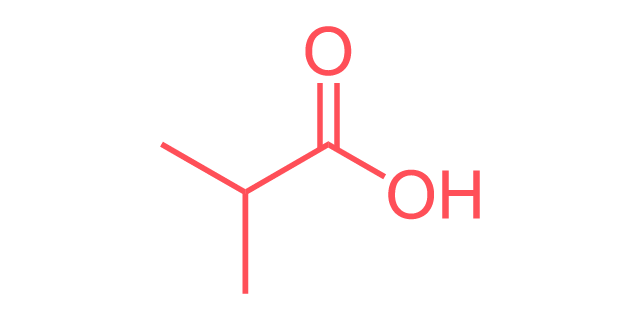Isobutyric Acid

Linear Formula
C4H8O2
Synonyms
2-Methylpropanoic acid, isobutanoic acid
Share this metabolite
What is Isobutyric Acid?
Isobutyric acid, or 2-Methylpropanoic acid, is a branched short-chain fatty acid (BSCFA)1. Short-chain fatty acids (SCFAs) are carboxylic acids and consist of two to six carbon atoms and short aliphatic tails. BSCFAs, although similar to SCFAs, are derived during the fermentation of branched-chain amino acids (valine, leucine, and isoleucine).
Isobutyric acid is a colorless liquid and has a characteristic odor of rancid butter. As a plant metabolite, isobutyric acid can be found in certain foods such as carob and vanilla, as well as fermented beverages1.
Bacterial members of the gut microbiome can also produce SCFAs through the anaerobic fermentation of indigestible fibers2. These bacteria also produce BSCFAs like isobutyric acid but in considerably lower amounts3.
Isobutyric Acid and Gastrointestinal Health
The SCFAs produced by gut microbes are important for gastrointestinal health. Although BSCFAs like isobutyric acid are produced in lower amounts, emerging research has identified links between isobutyric acid and gut health.
In one study involving human adults, fecal levels of isobutyric acid and other BSCFAs were negatively correlated with fiber intake and BSCFA levels; however, there were no correlations with BSCFA levels and BMI4. Although associations are emerging, ongoing research continues to unravel the relationship between the gut microbiome, isobutyric acid, and gastrointestinal health.

(Figure adapted from Salazar et al.)
Isobutyric Acid and Metabolic Health
BSCFAs have also been shown to impact metabolism and metabolic health. Similar to the effects of SCFAs on glucose and lipid metabolism, one in vitro study utilizing rat adipocytes found that administration of isobutyric acid increases insulin-stimulated glucose uptake and reduces phosphorylation of rate-limiting enzymes involved in lipolysis5. Overall, recent research is beginning to unravel the anti-obesogenic properties of BSCFAs like isobutyric acid.
Isobutyric Acid and Neuroscience
SCFAs and BSCFAs have also been implicated in modulating brain function. In experiments involving mouse models of Parkinson’s, researchers found that scheduled fasting has neuroprotective effects that are associated with changes in the gut microbiome. Interestingly, this study found that fasting in mice with characteristics of Parkinson’s reduces levels of isobutyric acid, and fecal transplants from normal, fasted mice to mouse models of Parkinson’se imparts neuroprotective effects6.
Isobutyric Acid and Cosmetics
The characteristic odor of isobutyric acid and its ester, isobutyrate, has been utilized in cosmetics and as a food additive. For example, benzyl isobutyrate has been used in shampoos and soaps for its fruity and jasmine-like odour7. Sucrose acetate isobutyrate is also commonly used as a “density-adjusting” agent in non-alcoholic carbonated and non-carbonated beverages8.
Isobutyric Acid and Drug Development
Isobutyric acid has seen considerable utility in drug development and the pharmaceutical industry. Flutamide, a nonsteroidal antiandrogen primarily used to treat prostate cancer, can be efficiently produced by acylating 4-nitro-3-trifluoromethylaniline with isobutyric acid chloride9.
References
- National Library of Medicine, National Center for Biotechnology Information (2023). PubChem Compound Summary, Isobutyric acid (CID 6590).
- Yuille, S., Reichardt, N., Panda, S., Dunbar, H., and Mulder, I.E. (2018). Human gut bacteria as potent class I histone deacetylase inhibitors in vitro through the production of butyric acid and valeric acid. PLoS One 13, e0201073.
- Lynch, C.J., and Adams, S.H. (2014). Branched-chain amino acids in metabolic signaling and insulin resistance. Nat Rev Endocrinol 10, 723-736.
- Rios-Covian, D., Gonzalez, S., Nogacka, A.M., Arboleya, S., Salazar, N., Gueimonde, M., and de Los Reyes-Gavilan, C.G. (2020). An Overview on Fecal Branched Short-Chain Fatty Acids Along Human Life and as Related With Body Mass Index: Associated Dietary and Anthropometric Factors. Front Microbiol 11, 973.
- Heimann, E., Nyman, M., Palbrink, A.K., Lindkvist-Petersson, K., and Degerman, E. (2016). Branched short-chain fatty acids modulate glucose and lipid metabolism in primary adipocytes. Adipocyte 5, 359-368.
- Zhou, Z.L., Jia, X.B., Sun, M.F., Zhu, Y.L., Qiao, C.M., Zhang, B.P., Zhao, L.P., Yang, Q., Cui, C., Chen, X., and Shen, Y.Q. (2019). Neuroprotection of Fasting Mimicking Diet on MPTP-Induced Parkinson’s Disease Mice via Gut Microbiota and Metabolites. Neurotherapeutics 16, 741-760.
- McGinty, D., Letizia, C.S., and Api, A.M. (2012). Fragrance material review on benzyl isobutyrate. Food Chem Toxicol 50 Suppl 2, S420-424.
- Reynolds, R.C., and Chappel, C.I. (1998). Sucrose acetate isobutyrate (SAIB): historical aspects of its use in beverages and a review of toxicity studies prior to 1988. Food Chem Toxicol 36, 81-93.
- Mohammad Ghaffarzadeh, S.R. (2014). A novel method for synthesis of flutamide on the bench-scale. Journal of Chemical Research 38.

